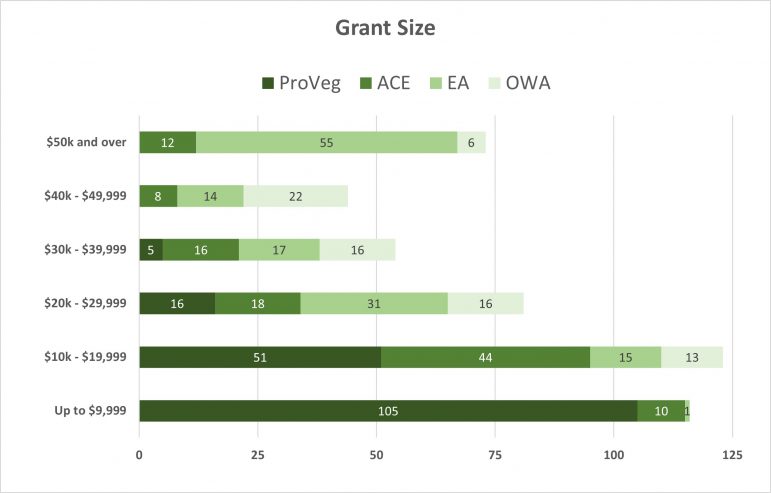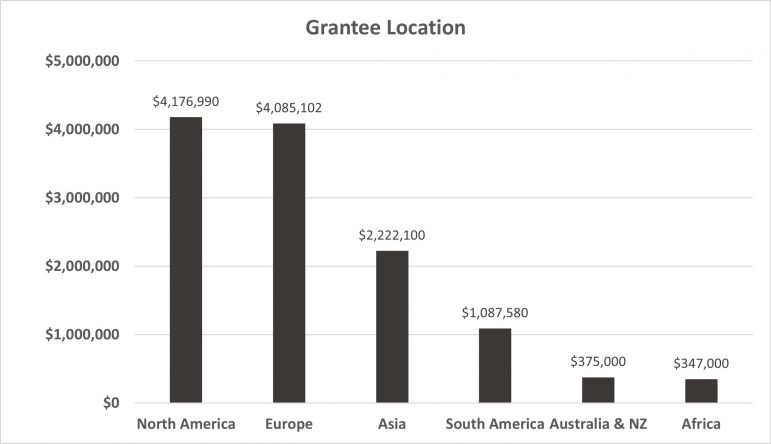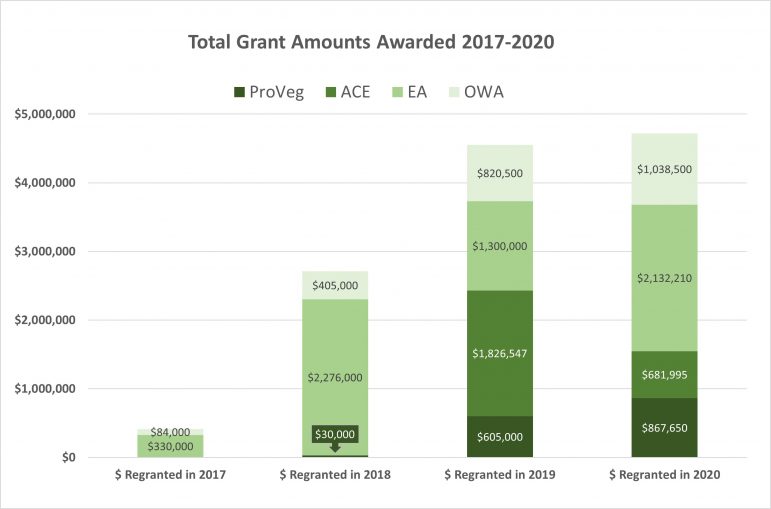I came to the animal advocacy movement with a passion for grassroots organizing. During my previous work in the human rights sector, I saw first-hand how communities change their circumstances with a small amount of capital and a large amount of belief and support. Now, as a Partner and Director of the Greenbaum Foundation, I’ve come to learn the goals, priorities, and biggest challenges faced by a different community: animal welfare advocates and funders.
From my position of power and privilege, one common concern I heard from many funders in our movement is the difficulty of identifying and effectively granting money to smaller recipients. The obstacle can be that the funder does not have a full-time staff person to engage in the vetting process, or the recipient is not registered in the US as a 501c3, resulting in the need to find fiscal sponsorship to transfer funds or, alternatively, to perform an Equivalency Determination on the grantee.
Having witnessed and experienced these same challenges in my work with the Greenbaum Foundation, I became connected to four entities that address the above roadblocks through an effective and equitable process to support our global movement: ProVeg Grants, EA Fund, ACE Movement Grants, and Open Wing Alliance (a program of The Humane League). By working with grant data from these four organizations, I identified key lessons and opportunities for funding the next wave of animal advocates worldwide.
To Have Big Impact, Give Small Grants
The animal advocacy movement has grown leaps and bounds over the last several decades. With this growth of momentum and funding, the movement has achieved admirable wins for animals. But our movement doesn’t begin and end with a small handful of large nonprofits that have long-term support, growing staffs, and dedicated funders. Like any people-powered grassroots movement for social and institutional change, our movement depends upon individual choices, happening collectively. All such movements start with the unique activist, the single picket sign, the loan tweet of dissent. Individuals are the key to our movement’s success. I wonder, have we forgotten this?
Even the most prominent players in animal rights and animal welfare started out small, building their power and reach over time through the work of individuals. Plant-based foods are bought by the individual consumer, corporate campaigns depend upon thousands of individual signatures from concerned citizens, and investigations must be tweeted and shared by an army of passionate change makers.
With all this in mind, I began to ask myself if we, as funders, have done enough to cultivate a growing grassroots movement. How might we be more effective at generating the movement of tomorrow from the starting seeds sown today?
Small Grants, International Reach
In our movement, there are many large grassroots nonprofits that are extremely organized, effective, and highly visible. Donating to these large recipients feels like a solid bet. This feeling comes from their good reputation, the ease of knowing that Executive Director for many years and attending multiple conferences together, and the security of knowing that other fellow funders financially invest in that group. I support many of these large organizations and believe in their work, but often wonder whether I should challenge myself to give outside that safety net. Could I have a larger impact by giving a fraction of that amount to ten activists or smaller groups?
Despite clear and measurable “wins” from the large nonprofits, our global problem of consuming animals is still increasing. We need new solutions and new funding pathways. We need to think creatively and do more to capture the minds and the markets of tomorrow. This means looking beyond established seats of grassroots animal activism in the United States to overseas contexts where these efforts are seeking support to develop critical local advocacy. It also means supporting and amplifying the voices of Black, Brown, and Indigenous activists everywhere who have been doing this work for decades.
If funders of animal rights want impactful animal charities to come into being where today there are none, we must first begin with strengthening the grassroots movement. This can be accomplished by supporting small groups and individual activists with training, mentorship, technical support, belief, and capital.
Unfortunately, it can often be a challenge to support smaller entities and individual activists, especially overseas. Monitoring and reporting are harder to accomplish at a distance. There is the ever-present complexity of working in different political contexts, and at times there is also a language barrier. Compared to large programmatic grants to an established nonprofit, small grants take more time, patience, and flexibility on the part of funders. Transferring funding into international spaces can often involve complicated and creative workarounds, especially where funders seek a US charitable tax deduction.
Rather than face this maze of complications and uncertainty, many funders have, thus far, preferred to grant to the large nonprofits. Focusing so much energy and funding on just a few large players has spurred rapid growth in those organizations, which has, at times, outpaced the establishment of best practices, true governance boards, and important HR guidelines. We saw the consequences of this in the #ARmetoo scandal a few years ago, and we are still trying to heal and build better organizations. Fewer funding recipients also means concentrating resources behind a few priorities and approaches rather than funding a diverse and responsive ecosystem of advocacy.
How Re-Granting Helps
So, what can funders do to get money out more effectively to a wide array of recipients, including international grantees? Re-granting through a US-based re-granting organization provides a solution for many of the biggest challenges, revealing a landscape of funding possibilities that otherwise would not exist.
Re-granting provides funders with the ease and assurance of a trusted partner for sourcing, vetting, and monitoring potential grantees and a secure financial pathway for transferring funds across borders. Trusted re-granting organizations can also help funders navigate potential hazards in the granting process, such as rules in some countries restricting the entry of foreign money and the ever-changing landscapes of politics and human rights protections.
Re-granting through a trusted partner can also allow a funder to diversify their giving by extending their reach across multiple countries, organizations, individuals, and interventions. Although there is a potential increased reporting burden associated with smaller grants, they can often be absorbed more efficiently and used more effectively in local contexts than larger sums of money.
Lessons from Four Years of Re-granting
In 2019, while collaborating with ProVeg International to create an accelerator program for vegan advocates, I began gathering data about re-granting programs in our movement. I later partnered with ProVeg and three other re-granting entities I knew through my work: EA Fund, ACE Movement Grants, and The Humane League’s Open Wing Alliance. They openly shared their data with me so that I could analyze overall trends.
I had come to believe that the existing funding pathways in our movement were missing opportunities to develop untapped potential among individuals in international markets. It seemed to me that the existing highly-capitalized mid- to large-scale interventions in the US and Europe, with historically white male leadership and close ties to unequal and exclusionary economies, would struggle to translate themselves into additional global contexts without the backing of a more diverse array of individuals. This pattern of funding also felt like a form of colonization that I was increasingly uncomfortable supporting.
So, I strove to test a theory that I had developed during my years in this field: that grants to individuals, particularly internationally, are a key and under-funded part of growing our global movement. The next international activist sensation could be a person in Colombia or Nigeria who receives a $1000 grant today. Would you have bet on Greta Thunberg? Would you have given her the first $1000 grant to host a rally? We simply cannot know who or what will be the tipping point to save our beloved planet.
To find out if I could show that re-granters were having promising success, I examined the grants given by these four re-granting organizations over the past four years to see where they had gone and what measurable gains had resulted. I explored the data by numbers of grants given, total amounts granted, destination countries, and quantifiable policy changes.
What I discovered was a fascinating pipeline for enabling the next big international force for animal advocacy.
Lesson 1. Re-granting to individuals is driving policy results
The early investment of the Open Wing Alliance and the EA Fund into Europe has yielded impressive results. Corporate commitments in Europe are soaring, animal welfare policy within the European Union is holding firm, and the emergence of organizations like Anima International and Essere Animali proves that globally recognized nonprofits can arise through this type of funding.
Lesson 2. Re-granting is significant and growing
Over the past four years, these four entities have re-granted more than $12 million dollars. The greatest fraction of that total, by a significant margin, comes via The EA Fund. My analysis documents a clear growth trend across these four re-grantors, from only a few hundred-thousand dollars re-granted in 2017 to close to $5M in 2020. There is growing awareness across the wider movement that there is a clear need to put more support behind international efforts, and these re-granting entities currently present the clearest way to do so.
The number of individual grants is increasing, as well as the overall size of the re-granting market. Many of these re-grantors began as small pilot projects and have built up capacity significantly over the past two years. Over the study time frame, there has been a huge increase in the number of re-grants, from 20 in 2017 to nearly 500 in 2020.
Lesson 3. Grants of many sizes are critical for a growth pipeline

There was a large range of grant sizes across the four re-grantors. For example, 60% of ProVeg’s grants were less than $10k dollars in size, while EA fund’s grants were typically over $60k. This heterogeneity is a good thing because it keeps opportunities available at every level. This can help fund a new nonprofit entity through the stages of its growth by ensuring that there is always a next grant available at the scale that will fit their evolving needs and capabilities.
Funders can sometimes lose sight of the challenges their grant recipients face in getting started. It is tempting to expect a large amount of personal buy-in upfront from a grant recipient who is just starting out. For recipients who face significant start-up barriers and do not have the privilege that we might, it can be a very hard choice to jump into full-time advocacy without a secure future pathway for growth.
In addition, does every activist who joins a picket line need to eventually run an organization? Instead of this ‘model and scale’ trap, our movement could be stronger if we build a supportive hierarchy of multiple levels of financial backing, plus mentorship and training. This would ensure that activists at every level can be sustained long-term without needing to give up their day jobs.
Lesson 4. Re-grants must recognize diverse local needs

Tracing the geographic distribution of grants by region, I found that the majority of the money moving through these entities goes to groups in North America and Europe. These two regions received similar totals of dollars re-granted, although Europe leads the way in the number of grants.
Although North America and Europe dominate the re-granting landscape thus far, most of the world’s industrially farmed animals—and most people eating them—reside in Asia. The farmed animal movement is still mostly in its infancy in Africa, where there have still been relatively few re-grants. This lack is due, in large part, to the fact that organizations in Europe and North America typically speak English and their local political structures mirror those with which US-based funders are already comfortable. Additionally, getting capital into Asia can be extremely challenging and potentially dangerous for the grantee. Let’s remember to protect the humans that are fighting for the animals.
How our movement responds to these emerging markets will decide how effective we can become. Over the next 5-10 years, re-granting entities are poised to play a significant role in growing advocacy capacity in highly neglected regions, including Africa, South America, and Asia.
Re-granting: The way of the future?
The year 2020 and the crisis of COVID-19 have forced many funders and nonprofits to take a step back and reassess their strategies. When opening back up, how will we improve the work we do? How can funders diversify our portfolios and extend our impact? To fulfill our mandate of creating lasting and widespread change, we need to be bolder and allow ourselves the opportunity to succeed at a global scale through re-granting. As part of this, we must be willing to release some control, ease out of our comfort zone, and believe in the ability of individual activism to lead to collective change.
Of course, we must continue to support the large nonprofits pushing significant policy change in the largest markets, engaging brands to achieve corporate commitments, and investigating ongoing animal abuses. But we must also be willing to engage with the thousands of individual activists fighting each day in places around the world for a different system, a healthier planet, and more empathy for animals. We must work to diversify funding so that it can support a global diversity of advocates.
Re-granting takes much of the guesswork out of creating global impact. For a fraction of the cost of a single large nonprofit grant in the United States or Europe, we can alternatively support, through re-granting, ten to twenty smaller groups or individual activists around the world. This is how we can succeed at truly shifting the narrative and building the capacity of the movement.
I have worked with grassroots activists for over a decade, and I can attest that a small amount of capital really ignites their spark. The financial investment itself is game-changing. But even more impactful is what that dollar represents: A belief, a trust, a recognition that we, the advocacy community, see them and recognize the value of their work. This recognition, paired with training, mentorship, education, and trust, is the winning formula for building the future we all hope to achieve, in which fewer animals are bred, harmed, and eaten.
Acknowledgments: This project and its outputs were made possible by the open sharing of re-granting data by ProVeg International, EA Fund, ACE Movement Grants, and Open Wing Alliance.






